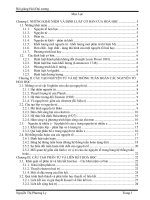ENGLISH PHONETICS Bài giảng dành cho sinh viên đại học cao đẳng
Bạn đang xem bản rút gọn của tài liệu. Xem và tải ngay bản đầy đủ của tài liệu tại đây (795.37 KB, 71 trang )
PHAM VAN DONG UNIVERSITY
FACULTY OF FOREIGN LANGUAGES
ENGLISH PHONETICS
AND PHONOLOGY LECTURES
(For English majors)
Lecturer: BUI THI THANH THUY
Quang Ngai, December 2016
0
TABLE OF CONTENTS
Page number
List of figures and tables
4
Chapter 1: Introduction
5
Lesson 1:Introduction: Phonetics and phonology
5
1.1. Phonetics
1.2. Phonology
Lesson 2:English vowels
11
1.3. Monophthong
1.4. Diphthongs
1.5. Triphthongs
Lesson 2:English consonants
14
1.6. Place of articulation
1.7. Manner of articulation
1.8. Voicing
Questions for discussion
1. What is phonetics?
2. What is phonology?
3. What are the differences between phonetics and a phonology?
4. How many English monophthongs/diphthongs/ triphthongs are there?
5. How many English consonants are there?
Chapter 2. The phoneme and the allophone
22
2.1. The phoneme and the allophone
2.2. The distinctive feature
2.3. The minimal pair
1
2.4. Symbols and transcription
Questions for discussion
1. What is a phoneme?
2. What is the distinctive feature?
3. What is the minimal pair?
4. What is narrow transcription?
5. What is broad transcription?
Chapter 3. The syllables
28
Lesson 1: The syllables and the structure of the syllable
28
3.1.The syllables
3.2.The structure of the syllable
Lesson 2: The syllable in Connected speech
32
3.3. An analysis of phonological structure
3.4. Syllabic consonants
3.5. Open syllables and closed syllables
3.6. Syllabification rules
3.7. Strong and week syllables
Questions for discussion + 15 minute Test
1. How many parts are there in an English syllable? What are they?
2. What is a strong syllable?
3. What is a weak syllable?
…
Chapter 4. Aspects of connected speech
38
4.1. Assimilation
4.2. Elision
4.3. Contraction
4.4. Linking
2
4.5. Strong forms and weak forms
Questions for discussion
1. What is assimilation?
2. How many types of assimilation are there?
3. What is elision? Give examples of different types of elision.
4. What is contraction? Give two examples
5. What is weak form? How many types of weak forms are there?
6. Chapter 5: The English stress and intonation
60
5.1. What is word-stress?
5.2. What is sentence-stress?
5.3. Levels of word stress and sentence-stress
5.4. Placement of stress in simple words and complex words
5.5. Types of main sentence-stress
5.6. Rhythm
5.7. Intonation
Questions for discussion + 50 minute Test
1. What kind of words are normally stressed in communication?
2. What kind of words are not normally stressed in communication?
3. What is rhythm? What are the differences between syllable-timed rhythm and
stress-timed rhythm?
4. How do yo understand the term intonation ?
5. What are the forms and meanings of the five basic tones. (Falling, Rising,
Falling-Rising, Rising-Falling, and Level) in English?
* The way in which this material is designed for students using the course under
the direction of the lecturer is as follows:
3
- All the students in the class read a chapter of this material.
- The students then have a class with the lecturer. This provides an opportunity to
discuss the material in the chapter, and for the lecturer to check if difficult points have
been understood. There are also some proper activities designed for students to follow.
- The students then goes on to the next chapter.
- All students need to do a 15minute test after finishing Chapter 3 and a 50 minute test
at the end of the course.
4
LIST OF FIGURES AND TABLES
Page number
Figure 1: The Human Hearing System
8
Figure 2: The Speech Organs
9
Figure 3: The Vowel Chart
11
Table 1: Place of Articulation
15
Table 2: Manner of Articulation
16
Table 3: The International Phonetic Alphabet
18
Table 4: English Syllable Structure
32
Table 5: Positional Occurrence of NAE Consonants
33
5
Chapter 1. INTRODUCTION
Time allotted: 3 weeks
Contents
Lesson 1: Introduction: Phonetics and phonology
Lesson 2: Vowels
Lesson 3: Consonants
Lesson 1: Introduction: Phonetics and Phonology
Aims: The aim of this lesson is to help students think about language systems and
students understand that there is a close link between phonetics and phonology. A list
of technical terms is also introduced at the end of this lesson.
1. Activity 1: Basic notions
Read the following basic notions that you need to know about, but then you can
develop your understanding if you want with other references.
Phonetics deals with the sounds of speech: the way we make them, the way we
classify them, and the way we perceive them.
Phonology also deals with the sounds of speech, but in a rather different way.
While phonetics deals with the individual sounds of any language and the details of
their formation, phonology deals with the ways in which the sounds in any given
language are related to each other and interact with each other. If we can use an
anology from music, phonetics tells you what it means to play an A, and why A on a
flute is different from A on a cello, but phonology tells you how that A can be used to
produce harmonies and tunes.
Morphology is about the structure of words, how words such as dislike are
made up of smaller meaningful elements, such as dis- and like.
Syntax is about the ways in which words can be put together to make up larger
units, such as sentences.
6
Semantics deals with meaning of an utterance.
Pragmatics deals with the way in which we use language to achieve our goals,
in ways which might not be obvious from the words we use. To take a simple example,
It’s cold in here might really mean ‘Will you please close the window?’ but is phrased
as a statement which does not require any response.
(From Laurie Bauer, 2012)
The place of phonology in the interacting hierarchy of levels in linguistics:
Pragmatics
Semantics
Syntax
Morphology
Phonology
Phonetics
2. Activity 2: Spoken language
δet’s continue with a piece of spoken language: Why don’t these alternatives
work as well as the original – “All right, have it your way - You heard a seal bark!” ?
(from The Seal in the Bedroom by J.Thurber)
Students should work in pairs or in small groups.The first one has been done for you.
a. You heard a seal berk. (This does not work because it is pronounced wrongly.)
b. You heard a seal moo.
c. You heard bark a seal.
d. You heard a seal barking.
e. Would you like to hear a seal bark?
f. Dear Albert, You heard a seal bark, Yours truly, Beryl.
g. A marine pinniped mammal going bow-wow was audible unto three.
3. Activity 3: Language systems
Each of the alternatives above (a-g) represents “Incompetence” in one of the
following systems. Can you match them? The first one has been done for you.
7
- Vocabulary: knowledge of what words mean and how they are used. (b)
- Syntax: knowledge of how words are ordered and sentences constructed.
- Appropriacy and style: knowledge of what language is appropriate according to one is
speaking to, about what and by what means.
- Phonology: knowledge of how to pronounce individual sounds, words and chunks of
speech.
- Grammar and morphology: knowledge of how words and phrases are marked for
tense, person, case, etc.
- Discourse competence: knowledge of different types of texts and their conventions.
- Pragmatic competence: knowledge of what forms are appropriate in order to realise
one’s communicative purpose (or function).
4. Activity 4: Get to know the human hearing System.
Figure 1: The human hearing system
8
5. Activity 5: Get to know the speech organs (sound producing systems)
Figure 2: The speech organs
Articulator
Alveolar ridge
Hard palate
Oral Cavity
Tip/Apex Tip/Apex
Blade/Lamina
Nasal Cavity
Velum
Uvula
Back/Dorsum
Pharynx
Epiglottis
Glottis
Larynx
Questions for discussion
1. What is phonetics?
2. What is phonology?
9
3. What are the differences between phonetics and phonology?
4. Where is the place of phonology in the interacting hierarchy of levels in linguistics:
5. Give the Vietnamese names for the articulators, then indicate them the correct places
on the sound producing systems.
Terminology
phonetics (n): ng âm h c (phonetics is the study of human speech sounds. It is a
branch of linguistics studying the production, the physical nature, the perception and
other aspects of human speech sounds.)
phonology (n): âm v h c (phonology is the study of how the speech sounds function
and form patterns according to phonological rules.)
morphology (n): hình thái h c
syntax (n): cú pháp h c
semantics (n): ng ngh a h c
pragmatics (n): ng d ng h c
discourse (n): di n ngôn
utterance (n): phát ngôn, l i nói, l i phát bi u
articulator: b ph n phát âm
Lesson 2: ENGLISH VOWELS
Aims: By the end of the lesson, students will be able to remember, use and pronounce
English vowels.
( Warm – up with www.youtube.com Lesson 36: Phonetics)
Vowels can be divided into vowels and consonants. Vowels can be divided into
pure vowels (monophthong) and diphthongs (and possibly triphthongs).
A vowel is defined as a voiced sound in which the air has a free passage
through the mouth, and does not produce any audible friction.
A pure vowel (monophthong) is an unchanging sound in the pronunciation
of which the organs of speech do not perceptibly change the position throughout
the duration of the vowel in a syllable. For example: /i/, /e/, /a/, /u/, …
10
A diphthong is a combination of two vowels pronounced within one
syllable. For example: /ei/, /
/,/ai/,…
A triphthong is a combination of three vowels pronounced within one
syllable. For example: /a
/, /
/, /ei /,…
1. Activity 1: Answer the following questions.
a. How many monophthongs are there?
b. How many long vowels are there?
c. How many diphthongs are there?
d. How many triphthongs are there?
2. Activity 2: Learn this vowel diagram in order to get familiar with it.
Figure 3: The vowel chart
Front
Central
Back
i
u
e
o
a
The columns show whether the tongue is toward the front, center, or back of the
mouth.
The rows show whether the tongue is high, in the middle, or low in the mouth.
Description of Cardinal Vowels
/I /
close front unrounded vowel
/e/
close-mid front unrounded vowel
/ /
open-mid front unrounded vowel
/a/
open front unrounded vowel
/ /
open back unrounded vowel
11
/ /
open-mid back rounded vowel
/o/
close-mid back rounded vowel
/u/
close back rounded vowel
/y/
close front unrounded vowel
/ø/
close-mid front rounded vowel
/œ /
open-mid front rounded vowels
/Π/
open front rounded vowel
/
/ open back rounded vowel
/ /
open-mid back unrounded vowel
/
/
/
/
close back unrounded vowel
/i /
close central unrounded vowel
/u/
close central rounded vowel
close-mid back unrounded vowel
Tense and lax vowels: Tense and lax vowel pairs, such as ‘feel-fit’, are difficult for
many students. Tense vowels are pronounced with more muscle tension. With lax
vowel, the muscles of the mouth are short in duration and more relaxed. Some writers
give the label tense to long vowels and diphthongs and lax to the short vowels. This is
explained in Jakobson and Halle (1964) and in Chomsky and Halle (1968).
Tense vowels:i:, u:, o, :
ei, I, ai …
Lax vowels:I, , æ, , , …
3. Activity 3: Noughts and crosses
Work in pairs or in groups. Make sentences using the vowel sounds in the boxex.
/i:/
/ I/
/eI/
/a
/ /
/ /
/
12
/aI/
/ :/
/æ/
(Teacher is the supervisor and flexible in students' answers.)
4. Activity 4: Lengthening sentences
Read these sentences aloud.
(Hand-out or link to file in Word )
* Hand-out for activity 4
Lengthening sentences
Concentrate on getting your breathing even and steady
1. Come to tea! Come to tea with me by the sea! If you're free, come to tea with me by
the sea. Do you agree, if you're free, to come to tea with me by the sea? /i:/
2. He's swimming. He's swimming in the river. He's swimming in the river with Tim.
Come in, he's swimming in the river with Tim. Will you come in-he's swimming in the
river with Tim. /I/
3. He sells eggs. He sells hens' eggs. He sells the best hens' eggs. He sells the best hens'
eggs every Wednesday. He sells the best hens' eggs every Wednesday in the market. /e/
4. He attacked the man. He attacked the man in the van. He attacked the man in the van
with the hammer. He attacked the man in the van with a hammer with he held with
both hands. /æ/
5. I shan't. I shan't sing. I shan't sing at the garden party. I shan't sing at the garden
party at my aunt's farm. I shan't sing at the garden party at my aunt's farm. I shan't sing
at the garden party at my aunt's farm tomorrow afternoon. /a:/
6. Where's the watch? Where's the watch I put in my pocket? Where's the watch I put
in my pocket to take to the shop? Where's the watch I put in my pocket to take to the
shop because it had stopped?/ /
7. Paul called. Paul called from the hall. Paul called from the hall that he slipped on the
floor. Paul called from the hall that he'd slipped on the floor and couldn't get the door.
/ :/
13
8. Have a look at this book. Have a look at this book which I found near a brook. Have
a look at this book which I found near a brook and gave to our cook. / /
9. I'd choose blue. I'd choose blue shoes. I'd choose blue shoes to take to school. I'd
choose blue shoes to take to school to use. I'd choose blue shoes to take to school to
use if I were you. /u/
10. You must come. You must come to supper. You must come to supper with us. You
must come to supper with us and join in the fun. / /
11. He searched and searched. He searched and searched for the bird. He searched and
searched for the bird he heard. He searched and searched for the bird he heard. He
searched and searched for the bird he heard in church. / :/
12. He built a protecting wall. He buit a protecting wall of shingle. He buit a protecting
wall of shingle and mortar . He buit a protecting wall of shingle and mortar to depend
the coast. / /
Questions for discussion:
1. What is the Cardinal vowel Diagram used for?
2. What is a vowel? A monophthong? A diphthong? A triphthong?
3. How do you classify English monophthong?
4. How do you classify English diphthongs?
5. How many triphthongs are there?
6. What are tense vowels?
7. What are lax vowels?
Terminology
monophthong: nguyên âm đ n, nguyên âm thu n túy (ch g m m t nguyên âm duy
nh t)
short vowel: nguyên âm ng n (có khuynh h
long vowel: nguyên âm dài (có khuynh h
ng ng n h n nguyên âm thu n túy)
ng dài h n nguyên âm thu n túy)
diphthong: nguyên âm đôi (nh trùng âm). δà âm nói đ
c hình thành t vi c đ c l
t
t m t nguyên âm sang nguyên âm th hai.
14
triphthong: nguyên âm ba (tam trùng âm). δà m t âm nói g m ba nguyên âm hình
thành t vi c đ c l
t t m t nguyên âm sang nguyên âm th hai và th ba.
tongue position: v trí l
i
tongue height: t m nâng c a l
i
lip rounding: đ tròn c a môi
to obstruct (v): c n tr (lu ng h i khi phát âm)
vowel quality: đ c tính c a nguyên âm
length-mark: ký hi u nguyên âm dài.
cardinal vowels: các nguyên âm chính (trong h th ng tham kh o chu n)
vowel qualdrilateral:hình t giác đ
c dùng đ mô t nguyên âm
Lesson 3: THE ENGLISH CONSONANTS
Aims: By the end of the lesson, students will be able to remember, use and pronounce
English consonants.
( Warm – up with www.youtube.com Lesson 36: Phonetics)
English speech sounds are devided into 12 monophthongs and 8 diphthongs mentioned
above and 24 consonants.
1. Activity 1: Read definitions of consonants and consonant classification
A consonant is a sound produced with an obstruction to the air stream.
According to Peter Roach (2002), we can classify the consonants according to the
place of articulation, the manner of articulation, and the state of vibration of the vocal
cords.
Place of articulation: The points where articulators actually touch or are at the closest.
Table 1: Place of articulation
Sound
Articulators
Active
bilabial
upper lip
E.g.
Passive
lower lip
p, b, m, w
15
dental
teeth
tongue tip
,
labial-dental
upper lip
lower lip
f, v
alveolar
tip
teeth ridge
t, d, s, z, n, l
palatal
front
hard palate
j
palato-alveolar
tongue blade
behind alveolar
∫, , t∫, d , r
tongue back
soft palate
k, g,
vocal cord
h
(post-alveolar)
velar
glottal
- bilabial:formed at the two lips
- labiodental: formed at the lips and teeth
- dental:formed at the teeth
- alveolar:formed at the tooth ridge
- palatal:formed at the hard palate
- velar:formed at the soft velar
- glottal:formed in the gap between the vocal cords
Table 2: Manner of articulation
Sound class
Movement of
Sound
articulators
16
stop (plosive)
complete stop of air, then [p, b, t, d, k, g]
rapid separation
affricate
stop of air, then slow
[ t∫, d ]
separation
fricative
Narrowing,
causing [ , , f, v, z, s, ∫, , h ]
audible friction
nasal
lowering of velum, air [m, n, ]
escapes through nose
lateral
air escapes down side of [l]
tongue
approximant
slight
narrowing,
not [w, j, r]
enough for friction
- plosive(or stop): by explosion
- fricative: by friction
- affricate: by explosion ending in friction
- semi-vowel: with little or no interruption or friction
17
Table 3: The International Phonetic Alphabet
18
States of glottis: what are the vocal folds doing?
Voiced sounds:
+ vibration during the articulation of the consonant,
e.g. [b, d, g, v, , r, d , , z, j, l, m, n, , w]
Voiceless sounds:
- vibration during the articulation of the consonant,
e.g. [p, k, t, , s, f, t∫, ∫, h]
For example, a voiced bilabial nasal is /m/.
A voiceless alveolar stop is /t/.
In addition, we can use vocing of English consonants in the pronunciation of Plural
form – S and the pronunciation of past form – ED.
2. Activity 2: Describe English consonants according to place of articulation,
manner of articulation and voicing.
/b/ is a voiced bilabial nasal sound.
/d/ is a voiced alveolar stop sound.
/g/ is a voiced velar stop sound.
/p/ is a voiceless bilabial stop sound.
/t/ is a voiceless alveolar stop sound.
/k/ is a voiceless velar stop sound.
/l/ is a voiced alveolar lateral sound.
/n/ is a voiced alveolar nasal sound.
/ / is a voiced velar nasal sound.
/d / is a voiced palato-alveolar affricate sound.
/t∫/ is a voiceless palato-alveolar affricate sound.
/r/ is a voiced palato-alveolar approximant sound.
/j/ is a voiced palatal approximant sound.
/w/ is a voiced bilabial approximant sound.
/m/ is a voiced bilabial nasal sound.
19
/v/ is a voiced labial dental fricative sound.
/ / is a voiced dental fricative sound
/z/ is a voiced alveolar fricative sound.
/ / is a voiced palato alveolar fricative sound.
/f/ is a voiceless bilabial dental fricative sound.
/ / is a voiceless dental fricative sound.
/s/ is a voiceless alveolar fricative sound.
/∫/ is a voiceless dental fricative sound.
/h/ is a voiceless glottal fricative sound.
3. Activity 3: Read about fortis – lenis consonants
There are some phonetic features of English consonants. Some of them require
greater or lesser effort and high/ low air pressure.
- Fortis consonants: voiceless consonants tend to have strong pronunciation.
e.g. [p, t, k]
- Lenis consonants: voiced consonants tend to have weaker pronunciation.
e.g. [b, d, g ]
4. Αχτιϖιτψ 4: Ρεαδ αβουτ σψλλαβιχ χονσοναντσ
A syllabic consonant is a consonant which forms the nucleus or the centre of a
syllable. It is the combination of vowel and a consonant in one sound: the syllabic
consonant. In the English language, the syllabic consonants are l, r, m, n,
as in
‘bottle, hungry, uppermost, thicken’. According to Peter Roach, ‘We find them
sometimes in words like ‘happen’, which can be pronounced [’hæpm]. If English
speaker can recognize these syllabic sonsonants, they can put the word stress more
easily. This will be mentioned in the next chapter.
Questions for Discussion
1. What is a consonant?
2. How do we classify English consonants?
3. What are the differences between vowels and consonants?
20
4. What is a syllabic consonant?
5. Describe each English consonant according to place of articulation, manner of
articulation and voicing.
6. What is a fortis consonant? Give two examples.
7. What is a lenis consonant? Give two examples.
Terminology
voicing:thanh tính
voiced sound: âm h u thanh. Khi các dây thanh âm rung đ ng thì s phát ra âm g i là
âm h u thanh. Có ba lo i bi n th h u thanh khác nhau:
- Bi n th v c
ng đ : âm h u thanh có c
ng đ cao khi la hét ho c c
ng đ th p
- Bi n th v t ng s : khi các dây thanh âm rung nhanh thì âm h u thanh
t n s cao
khi nói th m.
và ng
c l i.
- Bi n th v tính ch t: chúng ta có th t o ra các tính ch t c a âm h u thanh khác nhau
mà chúng ta th
ng g i là gi ng khàn, thì th m, h n h n…
voiceless sound: âm vô thanh (có nh ng đ c tính ng
c l i v i âm h u thanh)
vibration:s rung đ ng
aspiration: s b t h i
fortis: âm b t m nh
lenis:âm b t y u
glottal:âm h ng
glottal stop: âm t c thanh h u
glottal plosive:âm b c thanh h u
affricates:âm t c xát
fricative:âm xát
nasal:âm m i
lateral:âm bên
palatal:âm vòm ng c c ng
21
continuant consonant: ph âm xát
bilabial:âm hai môi
labiodental:âm môi r ng
dental: âm r ng
alveolar ridge: b r ng
alveolar:âm vòm l i
palato-alveolar:âm n u
syllabic sonsonant:ph âm t nó t o nên m t âm ti t, không c n có nguyên âm
approximant:âm ti m c n (các c quan phát âm ti n v phía nhau nh ng không đ g n
đ t o thành m t ph âm đ y đ )
22
Chapter 2: THE PHONEME AND THE ALLOPHONE
Time allotted: 3 weeks
Contents
1. The phoneme and the allophone
2. The distinctive feature
3. The minimal pair
4. Symbols and transcription
Aims: By the end of the lesson, students will be able to understand and use the term
‘phoneme’ and ‘allophone’ in pronunciation practice. They also know how to
transcribe English sounds phonemically and phonetically.
1. Activity 1: Read definitions of phoneme and allophone.
A phoneme is a phonological unit, a distinctive unit of sound in a language.
It is also defined as the smallest unit of language existing as such a speech-sound
which is capable distinguishing one word from another or one grammatical form
of a word from another form of the same word. Let us see two words pan and ban.
These two words have different initial sounds /p/ and /b/. /p/ and /b/ are phonemes in
English. There are 44 English phonemes: 20 vowels and 24 consonants.
According to Roach (2002), “When we speak, we produce a continuous stream
of sounds. In studying speech we divide this stream into small pieces that we call
segments. For examtheple, the word “man” is pronounced with a first segment /m/, a
second segment /æ/ and a third segment /n/. It is not always easy to decide on the
number of segments. To give a simple sentence, in the word “mine”, the first segment
is /m/ and the last is /n/. But should we regard the /ai/ in the middle as one segment or
two?”. In fact, this is still a controversal issue.
23
A phone is a term used in phonetics to refer to the smallest perceptible
discrete segment of sound in a stream of speech. A phonetic unit or phonetic
segment is called a phone. From the viewpoint of segmental phonology, phones are
the physical realizations of phonemes; phonic varieties of a phoneme are referred to as
allophones.
An allophone is a predictable phonetic variant of a phoneme. For example,
phoneme /t/ can have two variants. It can be aspirated as in tea [ti:] or it can be
unaspirated as in eat [i:t].
Phoneme
Allophone
- What you interpret
- What you hear
- Name for a class of sounds
- actual members of that class
- abstract unit of language
- concrete unit of speech
- phonemic (in dictionary)
- phonetic (in pronunciation)
- basic, underlying form
- phonetic realization/ variant
- socialized
- individual (free variation)
2. Activity 2: Read about distintive features in English.
- The distintive features help distinguish a segment from another one. It is also called
phonemic feature or contrastive feature because it helps distinguish different
phonemes. For example, the bilabial stops /p/ and /b/ can be distinguished only by the
feature voiceless sound and voiced sound.
- Minimal pair test is the basic test that helps discover which segment contrast.
- Minimal pair: A pair of words which mean something different and differ in only one
segment is called a minimal pair. For example, pat /pet/ and bat/bet/; bed/bed/ and bad
/bæd/; raise/reiz/ and race /reis/.
- Complementary distribution occurs when two or more segments never occur in the
same phonetic environment, they are said to be in complementary distribution. The
complementary distribution helps decide which segments are allophones of the same
phoneme. Eg, the complementary distribution of voiced [l] and voiceless[l] as in:
24









